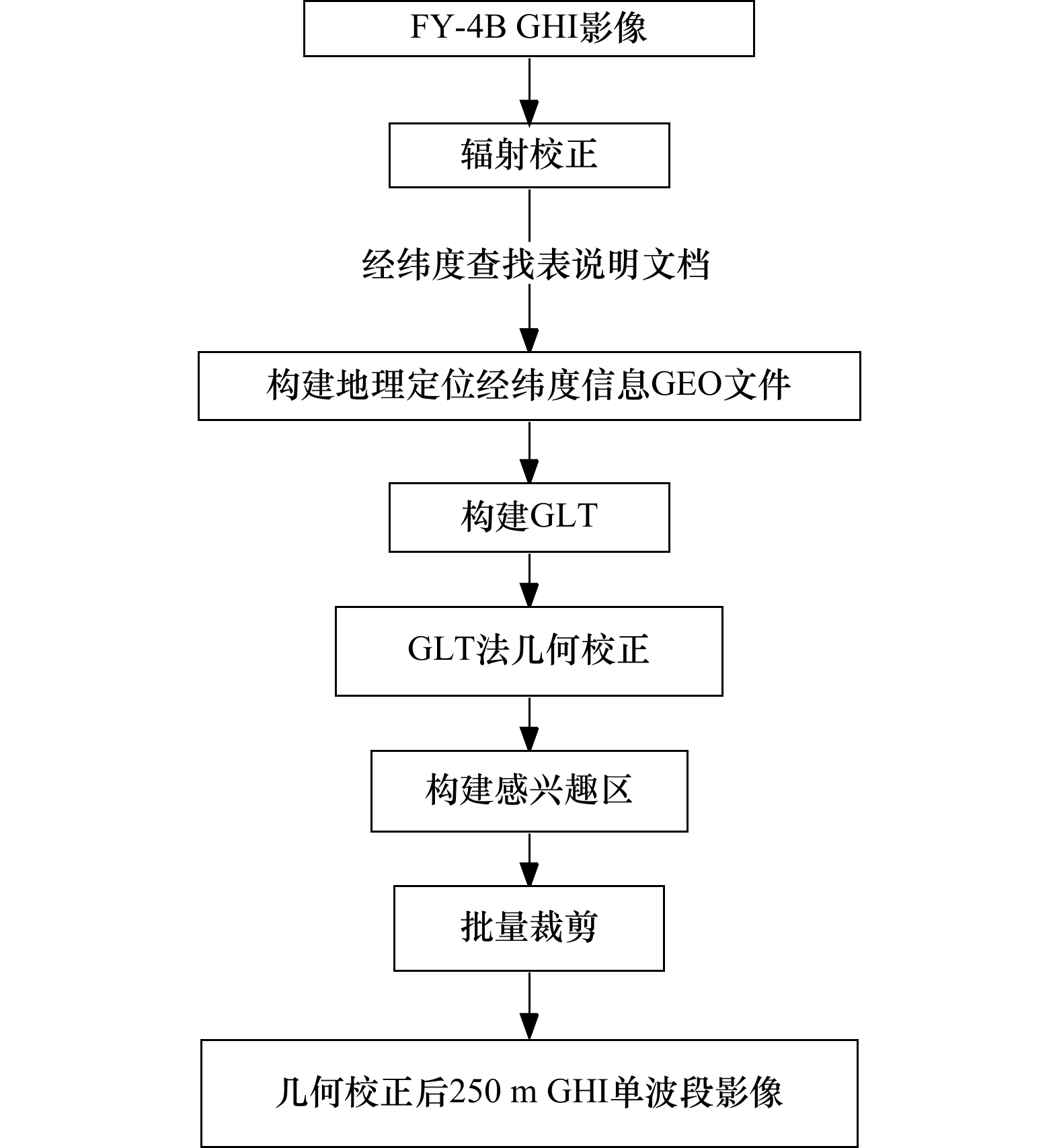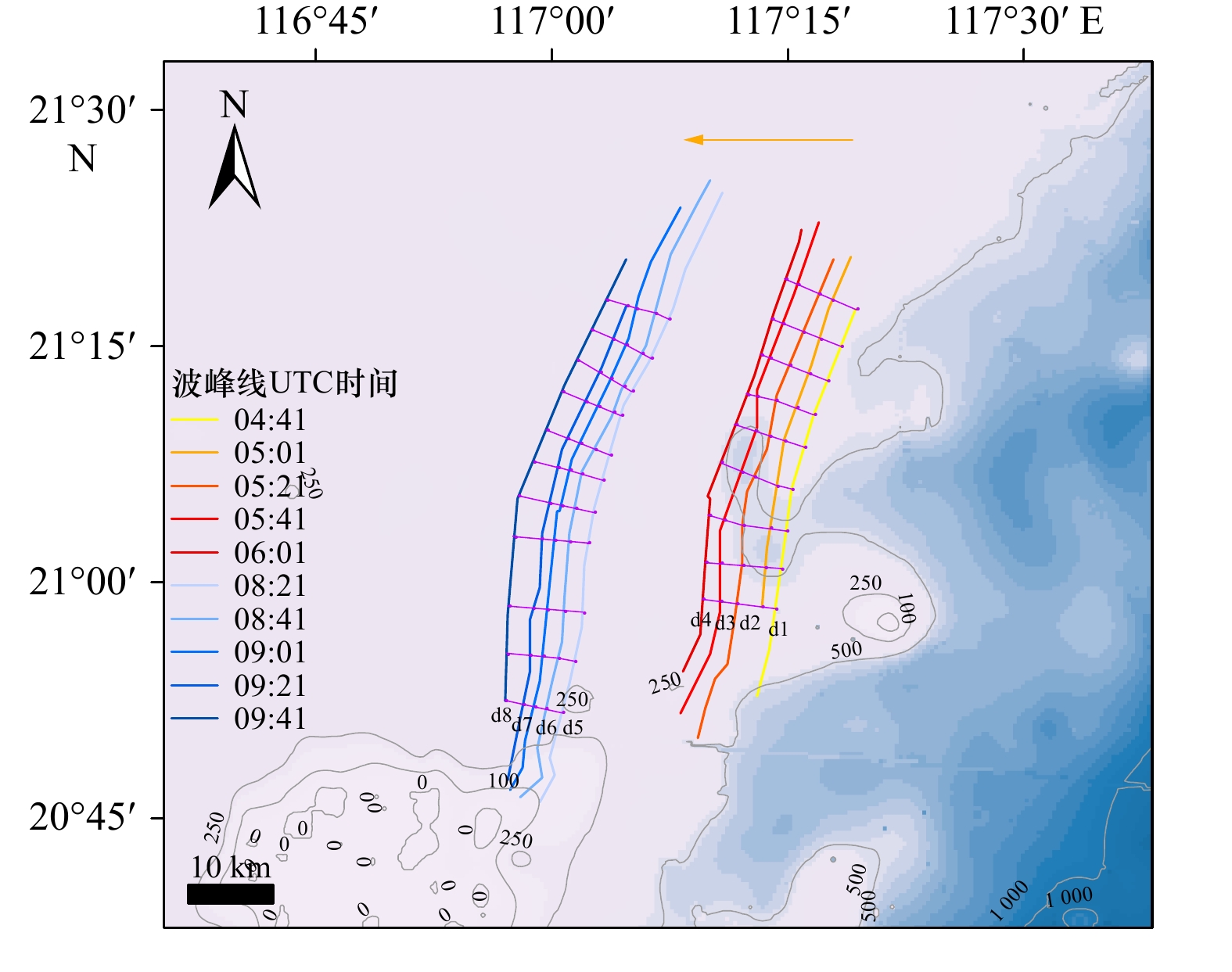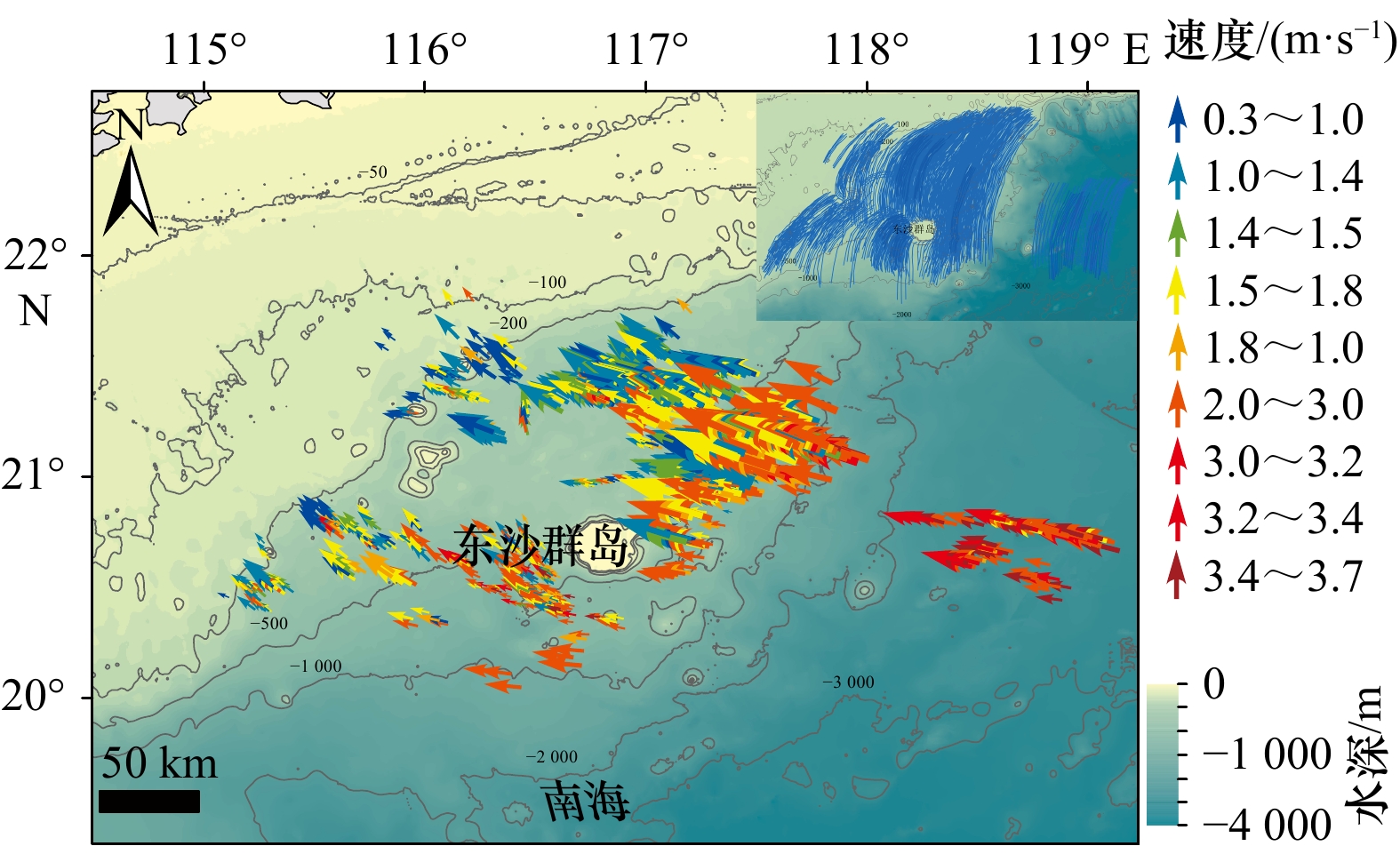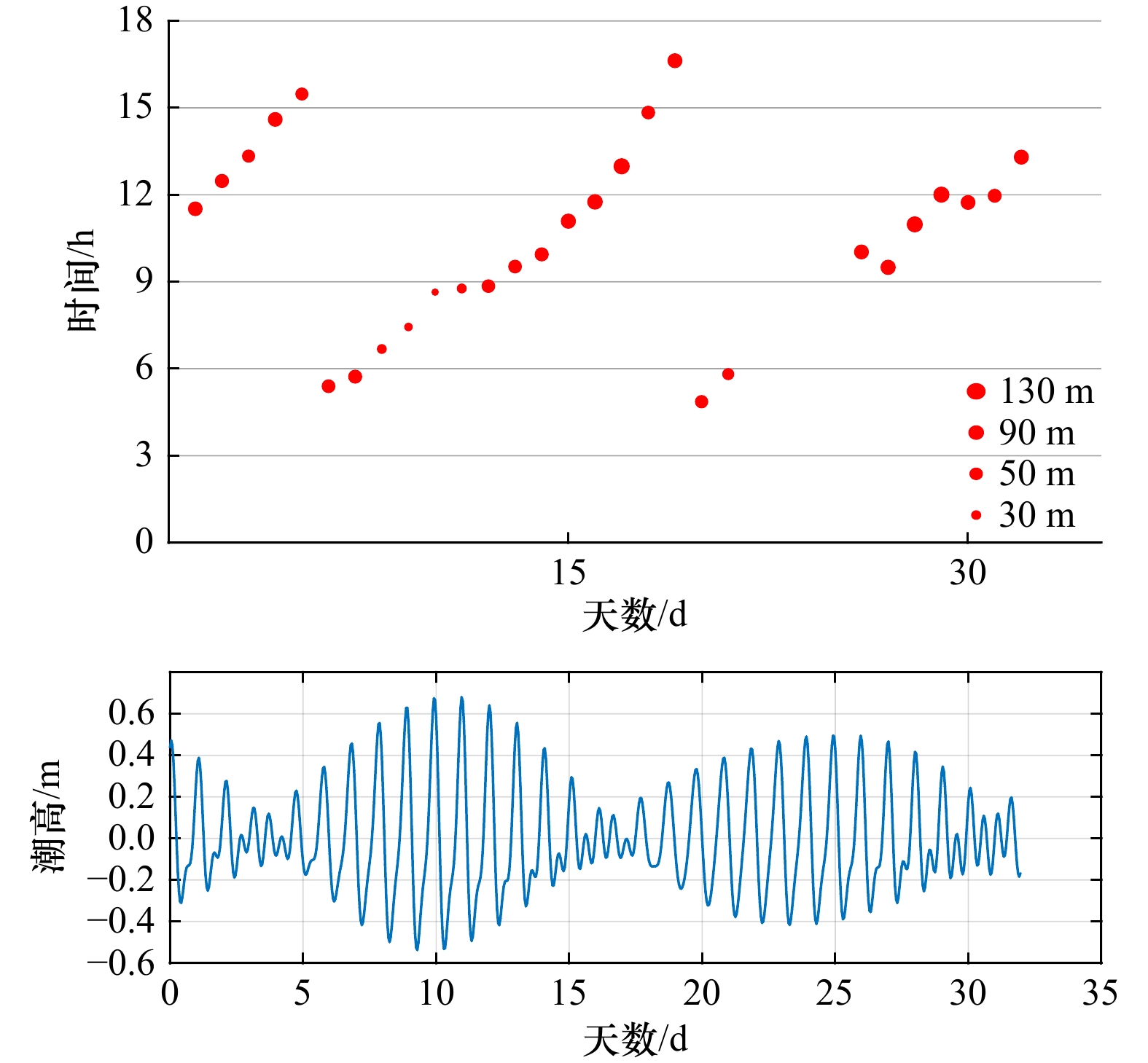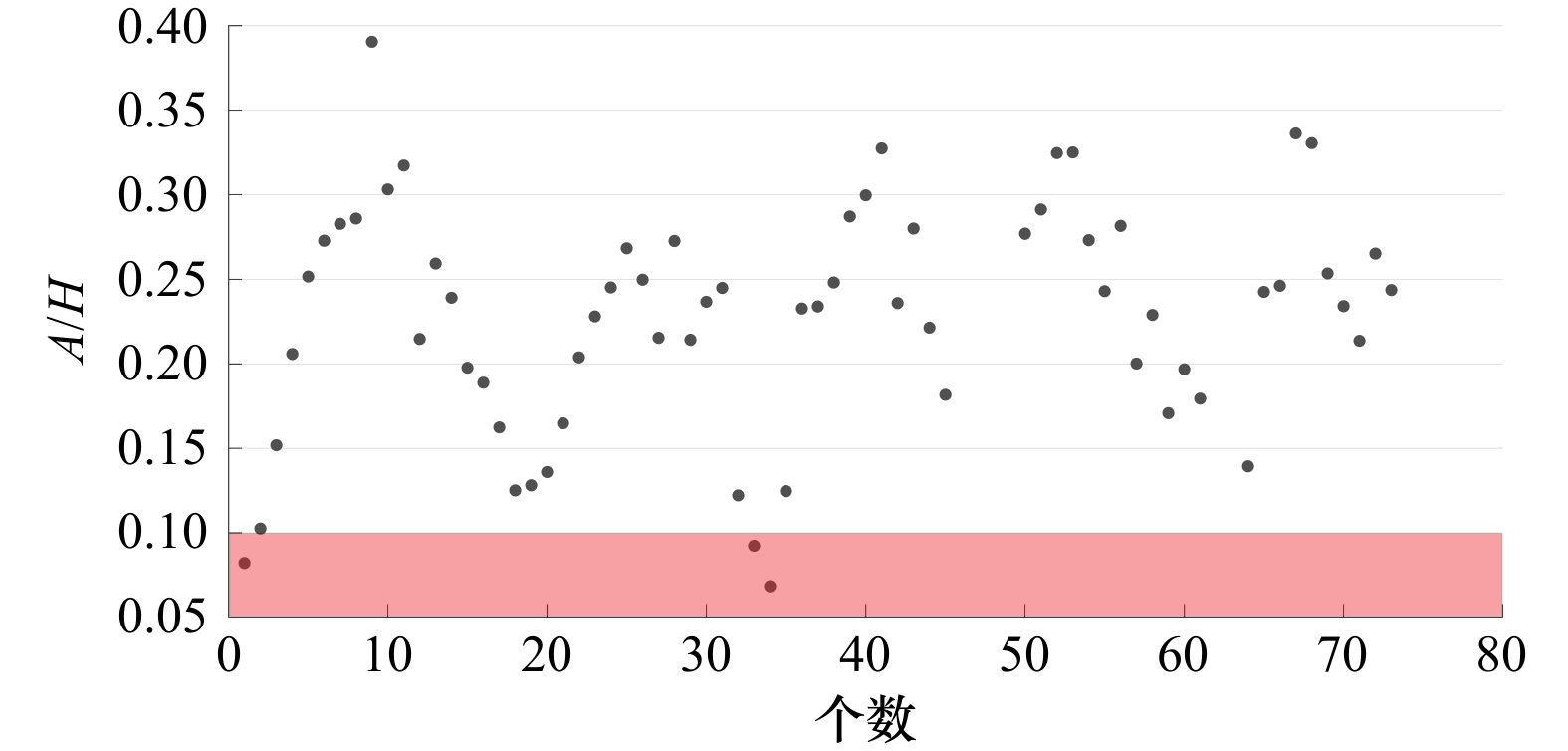Observation and propagation velocity study of internal solitary waves in the northern South China Sea based on the FY-4B geostationary meteorological satellite
-
摘要: 本文利用中国新一代静止轨道气象卫星FY-4B数据开展了南海北部海域内孤立波观测及传播速度研究。首先使用500 m分辨率的全圆盘ARGI数据对FY-4B卫星可观测内波区域进行了讨论,确认了南海北部为研究区域。之后利用250 m分辨率的GHI数据使用多时相图像比较法(Multitemporal Image Comparison Method,MTI)计算了南海北部内孤立波的传播速度,其平均传播速度为1.78 m/s,东部深海区平均传播速度为3.02 m/s,向西传播至东沙群岛附近后平均速度减小至1.90 m/s,经过东沙群岛分裂后南部比北部传播速度更快,分别为2.08 m/s 和1.54 m/s;最终在向西传播到近岸区域后内孤立波传播速度减小至0.42 m/s,直至最终消散。将MTI方法与两层模式下扩展KdV方程(extended Korteweg-de Vries,eKdV)计算得到的理论传播速度进行了对比,二者相关系数达到了0.89,证明eKdV理论方程对南海北部内孤立波传播速度反演的可行性,但仍具有一定的局限。最后将实测数据与遥感影像匹配计算内孤立波传播速度的结果与单一遥感影像计算内孤立波传播速度的结果进行了比较,两者相关性达到了0.93。本文验证了静止轨道卫星光学遥感数据的高时间分辨率特点对内孤立波传播速度研究具有的较大优势,对南海北部内孤立波参数反演等研究工作具有一定意义。
-
关键词:
- 内孤立波 /
- FY-4B地球静止气象卫星 /
- 多时相图像比较法(MTI) /
- eKdV方程 /
- 南海北部
Abstract: This study uses the data of the China’s new generation geostationary-orbit meteorological satellite FY-4B to observe the internal solitary wave (ISW) and study the propagation speed of ISW in the northern South China Sea (NSCS). Firstly, the observable ISW region of the FY-4B satellite was discussed by using ARGI data of 500 m resolution, and the NSCS was confirmed as the research area. Then, the MTI method (Multitemporal Image Comparison method) was used to calculate the propagation velocity of ISWs in NSCS using GHI data of 250 m resolution, and the average propagation velocity of ISW in NSCS is about 1.78 m/s. The average velocity in the eastern deep sea was 3.02 m/s, and it decreased to 1.90 m/s after westward transmission near Dongsha Islands. After the division of Dongsha Islands, the velocity of ISW in the south was faster than the north, with 2.08 m/s and 1.54 m/s, respectively. Finally, the velocity decreases to 0.42 m/s after westward to the nearshore region, then dissipates. Compared with the results of the MTI method and theoretical propagation velocity calculated by the eKdV (extended Korteweg-de Vries) equation in the two-layer mode, and the correlation coefficient between them reached 0.89. Prove the feasibility of using the eKdV theoretical equation to invert the propagation velocity of ISW in the NSCS. Finally, the results of calculating the propagation velocity of ISW by combining measured data with remote sensing images were compared with the results of MTI method. The correlation between the two reached 0.93. This article verifies the high temporal resolution characteristics of geostationary-orbit optical remote sensing data, which have significant advantages in calculating the propagation speed of ISW. It has certain significance for research work such as inversion of ISW parameters in the NSCS.-
Key words:
- ISWs /
- FY-4B geostationary meteorological satellite /
- MTI /
- eKdV equation /
- northern South China Sea
-
表 1 GHI数据及ARGI数据参数介绍
Tab. 1 Introduction of GHI and ARGI data characteristics
GHI ARGI 波段/μm 全色 0.55~0.75 空间分辨率/m 250 500 时间分辨率/min 1 15 探测范围 不定区域 固定区域 观测范围示意图 

表 2 FY-4B ARGI数据各海区可观测内波的最佳时间段
Tab. 2 The optimal time period of observed internal waves in each sea area of FY-4B ARGI data
海区 空间范围 日期 最佳时间段 南海北部 19°~22.5°N, 116°~120.5°E 2023年5月6日 03:00−07:00 UTC 苏禄海 6°~9°N, 117.5°~121.5°E 2023年5月12日 04:00−07:00 UTC 西里伯斯海 3°~6.5°N, 120°~124.5°E 2023年3月25日 04:00−07:00 UTC 弗洛勒斯海 5.5°~8.5°S, 122°~127°E 2023年3月24日 04:00−06:00 UTC 马鲁古海 0.5°~3.5°S, 123.5°~128°E 2022年6月1日 02:00−06:00 UTC 龙目海峡 6°S~9.5°S, 114°~118.5°E 2023年3月12日 04:00−07:00 UTC 表 3 MTI法计算内孤立波波速
Tab. 3 Calculating internal solitary wave velocity using MTI method
d1 d2 d3 d4 d5 d6 d7 d8 平均距离/km 2.114 2.380 2.177 1.996 1.761 1.725 1.405 2.967 传播时间/min 20 20 20 20 20 20 20 20 传播速度(vi)/(m·s−1) 1.76 1.98 1.81 1.66 1.47 1.44 1.17 2.47 时间段速度(v)/(m·s−1) 1.8025 1.6375 总平均($ \bar{v} $)/(m·s−1) 1.72 表 4 FY-4B数据与实测数据ISWs发生时间
Tab. 4 Time of occurrence of ISWs between FY-4B data and measured data
日期 7月20日 8月26日 8月27日 9月3日 9月13日 9月14日 9月15日 9月16日 成像时间1 04:00:00 03:01:00 03:11:00 07:01:00 04:01:00 05:01:00 06:01:00 06:41:00 成像时间2 05:30:00 01:17:00 01:12:00 06:48:00 05:21:00 03:38:00 04:36:00 06:01:00 实测发生时间3 05:29:00 01:16:40 00:47:30 06:48:20 02:12:30 03:37:40 04:35:50 05:59:30 时间1至时间2时间差/s 5 400 6 240 7 140 780 4 800 4 980 5 100 2 400 时间1至时间3时间差/s 5 340 6 260 8 610 760 6 510 5 000 5 110 2 490 时间1至时间2距离/m 9 940 10 669 11 880 1 237 9 330 9 472 8 622 5 294 时间1至时间3距离/m 10 253 10 825 15 291 1 177 12 716 9 351 7 912 5 400 时间1至时间2平均速度/(m·s−1) 1.84 1.71 1.66 1.59 1.95 1.90 1.69 2.21 时间1至时间3平均速度/(m·s−1) 1.92 1.73 1.77 1.55 1.95 1.87 1.55 2.17 相关系数R 0.93 -
[1] Meng Junmin, Sun Li’na, Zhang Hao, et al. Remote sensing survey and research on internal solitary waves in the South China Sea-Western Pacific-East Indian Ocean (SCS-WPAC-EIND)[J]. Acta Oceanologica Sinica, 2022, 41(10): 154−170. doi: 10.1007/s13131-022-2018-0 [2] Wang Tongxin, Huang Xiaodong, Zhao Wei, et al. Internal solitary wave activities near the Indonesian submarine wreck site inferred from satellite images[J]. Journal of Marine Science and Engineering, 2022, 10(2): 197. doi: 10.3390/jmse10020197 [3] Rivera-Rosario G A, Diamessis P J, Jenkins J T. Bed failure induced by internal solitary waves[J]. Journal of Geophysical Research: Oceans, 2017, 122(7): 5468−5485. doi: 10.1002/2017JC012935 [4] Liu Bingqing, Yang Hong, Ding Xianwen, et al. Tracking the internal waves in the South China Sea with environmental satellite sun glint images[J]. Remote Sensing Letters, 2014, 5(7): 609−618. doi: 10.1080/2150704X.2014.949365 [5] Huang Xiaodong, Chen Zhaohui, Zhao Wei, et al. An extreme internal solitary wave event observed in the northern South China Sea[J]. Scientific Reports, 2016, 6(1): 30041. doi: 10.1038/srep30041 [6] 孙丽娜, 张杰, 孟俊敏. 2010—2015年南海和苏禄海内孤立波时空分布特征分析[J]. 海洋科学进展, 2019, 37(3): 398−408.SUN Li’na, ZHANG Jie, MENG Junmin. Analysis of spatio-temporal distribution of internal solitary waves in the South China Sea and Sulu Sea (2010—2015)[J]. Advances in Marine Science, 2019, 37(3): 398−408. [7] Jackson C R. An empirical model for estimating the geographic location of nonlinear internal solitary waves[J]. Journal of Atmospheric and Oceanic Technology, 2009, 26(10): 2243−2255. doi: 10.1175/2009JTECHO638.1 [8] Zhang Xudong, Zhang Jie, Fan Chenqing, et al. Observations of internal waves with high sampling data of radar altimetry and MODIS images[J]. International Journal of Remote Sensing, 2018, 39(21): 7405−7416. doi: 10.1080/01431161.2018.1470700 [9] Zhang Xudong, Li Xiaofeng. Satellite data-driven and knowledge-informed machine learning model for estimating global internal solitary wave speed[J]. Remote Sensing of Environment, 2022, 283: 113328. doi: 10.1016/j.rse.2022.113328 [10] 胡蓓蕾. 基于高时间分辨率静止轨道光学卫星的海洋内波观测研究[D]. 青岛: 自然资源部第一海洋研究所, 2022.Hu Beilei. Oceanic internal waves observation based on high-temporal resolution geostationary orbit optical satellites[D]. Qingdao: First Institute of Oceanography, MNR, 2022. [11] 马志多, 孟俊敏, 孙丽娜, 等. 利用FY-4A气象卫星观测海洋内波[J]. 海洋科学, 2021, 45(2): 32−39.Ma Zhiduo, Meng Junmin, Sun Li’na, et al. Observation of internal waves in the ocean using FY-4A meteorological satellite[J]. Marine Sciences, 2021, 45(2): 32−39. [12] Li Xiying, Meng Junmin, Sun Li’na, et al. A study of internal solitary waves in the northern South China Sea using the Geo High-Speed Imager of the FY-4B satellite[J]. International Journal of Remote Sensing, 2023, 44(7): 2216−2235. doi: 10.1080/01431161.2023.2197132 [13] Lindsey D T, Nam S H, Miller S D. Tracking oceanic nonlinear internal waves in the Indonesian seas from geostationary orbit[J]. Remote Sensing of Environment, 2018, 208: 202−209. doi: 10.1016/j.rse.2018.02.018 [14] Garcia H E, Boyer T P, Baranova O K, et al. WORLD OCEAN ATLAS 2018 product documentation[R]. Silver Spring: Ocean Climate Laboratory, NCEI/NESDIS/NOAA, 2019. [15] Zhao Zhongxiang, Klemas V, Zheng Quanan, et al. Estimating parameters of a two-layer stratified ocean from polarity conversion of internal solitary waves observed in satellite SAR images[J]. Remote Sensing of Environment, 2004, 92(2): 276−287. doi: 10.1016/j.rse.2004.05.014 [16] 甘锡林, 黄韦艮, 杨劲松, 等. 利用多源遥感卫星数据研究南海内波的时空分布特征[J]. 遥感技术与应用, 2007, 22(2): 242−245.Gan Xilin, Huang Weigen, Yang Jinsong, et al. The study of spatial and temporal distribution characteristics of internal waves in the South China Sea from multi-satellite data[J]. Remote Sensing Technology and Application, 2007, 22(2): 242−245. [17] Li Xiaofeng, Jackson C R, Pichel W G. Internal solitary wave refraction at Dongsha Atoll, South China Sea[J]. Geophysical Research Letters, 2013, 40(12): 3128−3132. doi: 10.1002/grl.50614 [18] Korteweg D J, De Vries G. XLI. On the change of form of long waves advancing in a rectangular canal, and on a new type of long stationary waves[J]. The London, Edinburgh, and Dublin Philosophical Magazine and Journal of Science, 1895, 39(240): 422−443. doi: 10.1080/14786449508620739 [19] Sun Li’na, Zhang Jie, Meng Junmin. Study on the propagation velocity of internal solitary waves in the Andaman Sea using Terra/Aqua-MODIS remote sensing images[J]. Journal of Oceanology and Limnology, 2021, 39(6): 2195−2208. doi: 10.1007/s00343-020-0280-6 [20] Yang Hong, Liu Bingqing, Zhao Zhongxiang, et al. Inferring internal wave phase speed from multi-satellite observations[C]//Proceedings of 2014 IEEE Geoscience and Remote Sensing Symposium. Quebec City: IEEE, 2014: 4768-4771. [21] Farmer D M, Alford M H, Lien R C, et al. From Luzon strait to Dongsha Plateau: stages in the life of an internal wave[J]. Oceanography, 2011, 24(4): 64−77. doi: 10.5670/oceanog.2011.95 [22] 孙丽娜, 张杰, 孟俊敏. 基于遥感与现场观测数据的南海北部内波传播速度[J]. 海洋与湖沼, 2018, 49(3): 471−480.Sun Li’na, Zhang Jie, Meng Junmin. On propagation velocity of internal solitary waves in the northern South China Sea with remote sensing and in-situ observations data[J]. Oceanologia et Limnologia Sinica, 2018, 49(3): 471−480. [23] Rong Lintai, Xiong Xuejun, Chen Liang. Assessment of KdV and EKdV theories for simulating internal solitary waves in the continental slope of the South China Sea[J]. Continental Shelf Research, 2023, 256: 104944. doi: 10.1016/j.csr.2023.104944 [24] Grimshaw R, Pelinovsky E, Talipova T, et al. Simulation of the transformation of internal solitary waves on oceanic shelves[J]. Journal of Physical Oceanography, 2004, 34(12): 2774−2791. doi: 10.1175/JPO2652.1 [25] Xue Jingshuang, Graber H C, Lund B, et al. Amplitudes estimation of large internal solitary waves in the Mid-Atlantic Bight using synthetic aperture radar and marine X-band radar images[J]. IEEE Transactions on Geoscience and Remote Sensing, 2013, 51(6): 3250−3258. doi: 10.1109/TGRS.2012.2221467 [26] 曾智, 李晓明, 任永政, 等. 基于TerraSAR-X卫星数据的内孤立波参数和海表流速信息提取的探索研究[J]. 海洋学报, 2020, 42(1): 90−101.Zeng Zhi, Li Xiaoming, Ren Yongzheng, et al. Exploratory research on the retrieval of internal wave parameters and sea surface current velocity based on TerraSAR-X satellite data[J]. Haiyang Xuebao, 2020, 42(1): 90−101. [27] Lien R C, Tang T Y, Chang M H, et al. Energy of nonlinear internal waves in the South China Sea[J]. Geophysical Research Letters, 2005, 32(5): L05615. [28] Li Xiaofeng, Zhao Zhongxiang, Pichel W G. Internal solitary waves in the northwestern South China Sea inferred from satellite images[J]. Geophysical Research Letters, 2008, 35(13): L13605. [29] Grue J, Trulsen K. Waves in Geophysical Fluids: Tsunamis, Rogue Waves, Internal Waves and Internal Tides[M]. Vienna: Springer, 2006. [30] Cui Junnan, Dong Sheng, Wang Zhifeng. Study on applicability of internal solitary wave theories by theoretical and numerical method[J]. Applied Ocean Research, 2021, 111: 102629. doi: 10.1016/j.apor.2021.102629 [31] Jia Tong, Liang Jianjun, Li Xiaoming, et al. Retrieval of internal solitary wave amplitude in shallow water by tandem spaceborne SAR[J]. Remote Sensing, 2019, 11(14): 1706. doi: 10.3390/rs11141706 [32] Kawaguchi Y, Wagawa T, Yabe I, et al. Mesoscale-dependent near-inertial internal waves and microscale turbulence in the Tsushima Warm Current[J]. Journal of Oceanography, 2021, 77(2): 155−171. doi: 10.1007/s10872-020-00583-1 [33] Chen Zhiwu, Xie Jieshuo, Wang Dongxiao, et al. Density stratification influences on generation of different modes internal solitary waves[J]. Journal of Geophysical Research:Oceans, 2014, 119(10): 7029−7046. doi: 10.1002/2014JC010069 [34] Xie Huarong, Xu Qing, Zheng Quanan, et al. Assessment of theoretical approaches to derivation of internal solitary wave parameters from multi-satellite images near the Dongsha Atoll of the South China Sea[J]. Acta Oceanologica Sinica, 2022, 41(6): 137−145. doi: 10.1007/s13131-022-2015-3 [35] 王晶, 郭凯, 孙美玲, 等. 3层模型的内波传播方程与参数反演[J]. 遥感学报, 2015, 19(2): 188−194.Wang Jing, Guo Kai, Sun Meiling, et al. Nonlinear Schrὅdinger equation and parametric inversion of internal wave propagation using three-layer model[J]. Journal of Remote Sensing, 2015, 19(2): 188−194. -





 下载:
下载:


